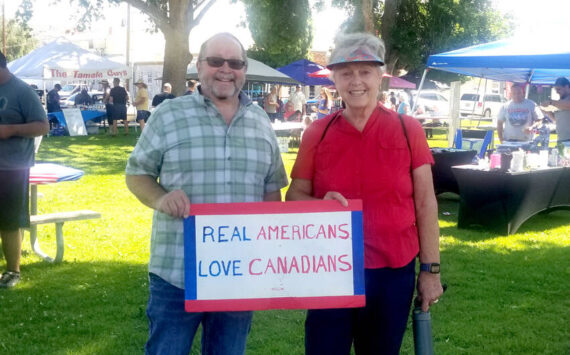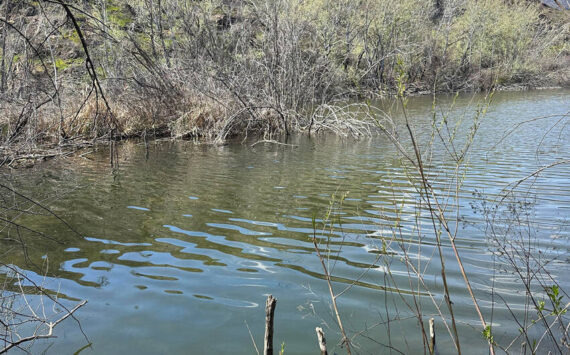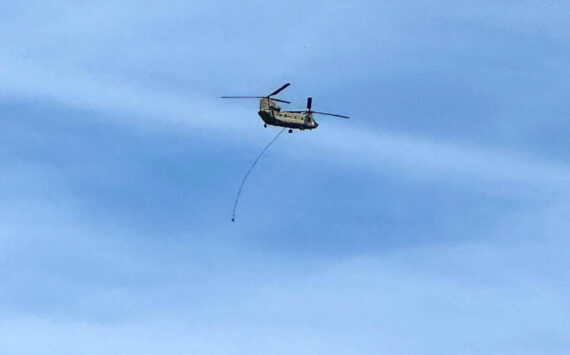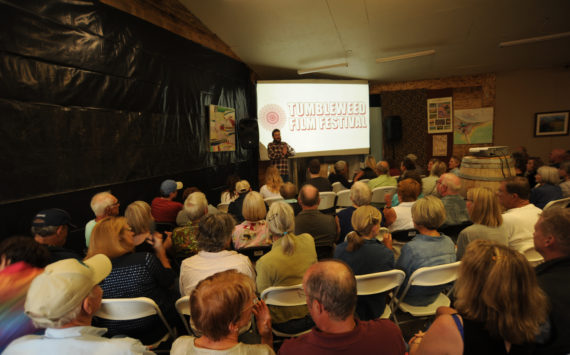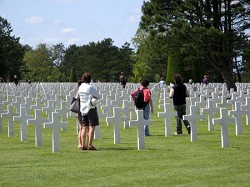
Row after row of white crosses and Stars of David, fill the Normandy American Cemetery in France. The burial ground overlooks Omaha Beach, site of part of the D-Day Invasion. Photo by Gary DeVon
Visiting the D-Day Invasion sites was an overwhelming emotional experience
Some of you may have noticed I’ve been missing the last couple weeks, that’s because my mom, uncle and I went to visit my younger brother and his family who live on the Isle of Guernsey, one of the Channel Islands.
While Guernsey has a facinating history in itself, dating back to before the time of castles and knights, as well as its occupation by the Germans during WWII, its close proximity to Normandy in France gave us the opportunity to travel to the places where the allies began their invasion of Europe to free it from the grasp of the Nazis. 
Mom, Michael, Uncle John and I took a ferry across the channel, landing near the walled port city of San Malo. From there we first went to see the incredibly beautiful Mont Saint Michel, rising like an mirage from the sea, then it was off to see the Church at Saint Mere Eglise, the first town to be liberated in France. It is also where American paratroops had gone off course, many were shot by the German and Austrian occupiers as they helplessly floated down from the sky. You might recall the scene in the movie The Longest Day where Red Buttons dangles from the church, his parachute caught in the steeple. This is where that happened in real life and a parachute with mannikin paratrooper was hanging from the steeple when we visited.
The next day we travelled first to see the artificial harbor constructed to allow the allies to bring in supplies for Operation Overlord. Then it was off to the Memorial de Caen (Peace Museum), stopping along the way at a cemetery we happened upon on a back road. The cemetery was filled with British soldiers and sailors who died during the D-Day Invasion. One section of the well-tended graveyard also included many headstones that indicated German forces who had died in the invasion were buried there as well.  
The Memorial de Caen takes you from the earliest days of the Nazis coming to power, their blitzkrieg through Europe, the terrible deportation of Jews and others to the death camps, the French Resistance, Britain’s lonely battle against the German juggernaut, the Attack on Pearl Harbor, the war in Russia and America’s entrance into the war and the eventual D-Day invasion by the allies that would free Europe from the Nazi’s grasp. Tales of soldiers on both sides of the war can be read and heard at the museum and the equipment and armament, from what each soldier took to the battlefield from shaving gear to rifles and jeeps can be seen there.
Like many, I’ve learned about D-Day through books and movies like the Longest Day and Saving Private Ryan, the History Channel and the HBO series Band of Brothers. While all informative in their own ways, I’m glad I was getting to see the places that honor the many brave men and women who made the ultimate sacrifice in the fight for freedom.
We next visited the Normandy American Cemetery and Memorial, the same cemetery that can be seen at the end of the movie Saving Private Ryan. Going inside the large visitor center first and reading about the sacrifices American soldiers, sailors and pilots made during the invasion – the wounded and the lives lost – like the Memorial de Caen, it was hard to keep a dry eye. I’m not ashamed to say each heart-wrenching story made me want to weep and proud to be an American at the same time. Following this with a trip to the memorial built to honor the American forces and the graveyard with row upon row of white headstones is emotionally overwhelming. The burial ground overlooks Omaha Beach, where the Americans suffered some 2000 casualties. 
We finished the day with a trip to Utah Beach, which stands in stark contrast to what we had seen at Omaha Beach. Maybe it was because the casualties were light there by comparison. There is a somber stone memorial and a rather avant garde statue, “Les Braves,” and you can read about the invasion on plaques that line the beach wall, but on that sunny weekday, the beach was filled with families, sun bathing and swimming, enjoying the warm weather – perhaps as it should be.
It’s common here to think of the French as ungrateful for what the allies did in helping to free them from Nazi tyranny, but one only has to look around to see American flags waving everywhere you go. A skeptic might think it is because of all the American tourists who come to see where so many of their fellow countrymen gave so much. I like to think the French people, like most of Europe, are still grateful for America’s part in helping to eliminate the Nazi threat and bring peace, for however short-lived, back to the world.

